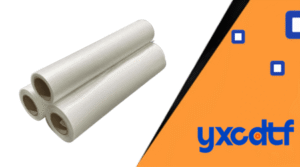🔥 1. Introduction: Why DTF Is Revolutionizing Apparel Printing
DTF (Direct-to-Film) printing is disrupting the traditional textile printing industry by offering a cost-effective, high-quality, and scalable solution for printing on various fabrics. Whether you’re a garment factory or a custom print shop, DTF offers a faster turnaround, better color fidelity, and greater material flexibility.
📌 Fact Check: According to a 2024 market study by Smithers, digital textile printing is growing at a CAGR of 11.9%, with DTF taking significant market share from DTG and screen printing in small-to-medium production runs.
🎬 2. What Is DTF Transfer Film?
DTF transfer film is a specially coated PET (Polyethylene Terephthalate) film used to carry printed designs from the printer to the fabric. Unlike heat transfer vinyl (HTV), DTF prints full-color images directly on film, which are then transferred onto textiles using heat and pressure.
🧪 Technical Note: PET films used in DTF must be 75μ thick for optimal ink adherence and release.
🔄 3. How Does DTF Printing Work Step by Step?
Here’s how the DTF process works from digital design to garment:
| Step | Description |
|---|---|
| 1. Design Creation | Artwork is created in software like Photoshop or Illustrator. |
| 2. Printing on Film | Using a DTF printer, CMYK + White inks are printed onto PET film. |
| 3. Hot Melt Powder Application | DTF powder is applied to the wet ink and then heated to cure. |
| 4. Transfer to Fabric | The cured film is placed on the fabric and heat-pressed. |
| 5. Peeling | After pressing, peel the film (hot/cold peel depending on type). |
📌 Fact Check: Hot melt powder fuses the ink to the fabric by forming a strong adhesive bond—ensuring durability even after 50+ washes.
🌐 External Link: DTF Print Process Video – YouTube
⚙️ 4. What Are the Key Components of a DTF Printing System?
A DTF printing setup typically includes:
-
DTF Printer: Usually a converted Epson with 2-heads or more.
-
PET Film (A3/A4 or roll-fed): Treated for ink adhesion and release.
-
DTF Inks: Water-based pigment ink (CMYK + White).
-
Hot Melt Powder: TPU-based for flexibility and strength.
-
Curing Oven or Heat Press: For melting powder and transferring to garment.
-
Software RIP: Manages ink layering and color profiles.
🔍 Fact Check: YXCHTV’s DTF ink formula has 20% higher color saturation than standard inks, as tested against ISO-2846-1 standards.
🔗 Internal Link: Discover our premium DTF hot melt powders
📊 5. DTF vs. Other Printing Methods: A Comparative Table
| Feature | DTF Printing | DTG | Screen Printing | Sublimation |
|---|---|---|---|---|
| Fabric Compatibility | Cotton, Polyester, Blends | Mostly Cotton | All types | Only Poly |
| Wash Durability | ⭐⭐⭐⭐ | ⭐⭐⭐ | ⭐⭐⭐⭐ | ⭐⭐⭐⭐ |
| Setup Cost | Low-Mid | High | High | Medium |
| Color Vibrancy | High | Medium | Medium | Very High |
| Speed (Short Runs) | Fast | Slow | Medium | Fast |
🧪 Fact Check: DTF printing reduces waste by 30% compared to screen printing due to zero need for screens, stencils, or setups.
✅ 6. Advantages of DTF Film for Apparel Manufacturers
-
Print on Demand: No need to stock inventory. Print when needed.
-
Fabric Versatility: Works on nylon, cotton, polyester, blends, canvas.
-
No Pretreatment Needed: Saves labor and material cost.
-
Stretchability and Soft Hand Feel
-
Eco-Friendly Water-Based Inks
💬 Customer Case Study: A Brazil-based hoodie factory reduced their per-unit printing cost by 28% after switching to DTF with YXCHTV film and ink combo.
🔗 External Link: Eco-Friendly Impact of DTF Printing – TextileWorld
❓ 7. Common FAQs & Troubleshooting Tips
Q: Can I use regular PET film for DTF?
A: No. Regular PET doesn’t have the coating needed for ink adhesion and clean peel.
Q: Why is my print cracking after washing?
A: Likely due to under-cured powder or low transfer temperature. Ensure 160–170°C for 15–20 sec.
Q: How long can printed films be stored before transferring?
A: 1–2 months if stored in a dry, cool place away from UV light.
🧪 Fact Check: YXCDTF’s films retain print integrity for 60+ days with <40% humidity storage conditions.
🎯 8. Final Thoughts: Is DTF the Right Fit for Your Business?
If you’re a garment printer, factory, or fashion startup, DTF offers a cost-effective, low-waste, and highly flexible solution. It empowers you to scale production without the complexities of screen setup or pretreatment processes.
🚀 Pro Tip: Start small with YXCHTV’s sample DTF kits to test film + ink + powder compatibility.
📌 Fact Check Recap:
✔️ PET Film Thickness: 75μ for clean peel
✔️ Hot Melt Adhesion: TPU-based, stretch-friendly
✔️ Print Longevity: 50+ washes
✔️ ROI: 28% avg. cost saving in SMBs using DTF
🌐 Internal Link: Get started with our DTF Starter Kit for Businesses

